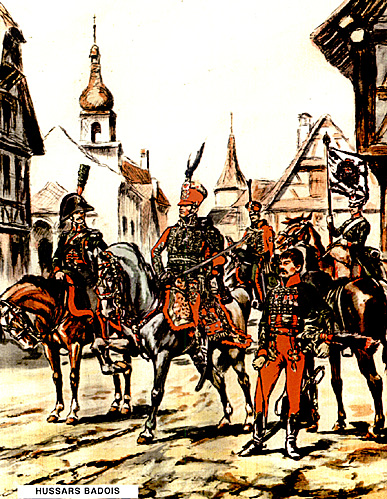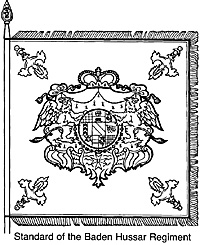Illutrations courtesy of Hourtoulle Soldats et Uniformes du premier Empire and Osprey Flags of the Napoleonic wars Vol. 1 to whom we express our thanks.
 Hussars
Hussars
The Hussars wore a dark green dolman with red collar and pointed cuffs. The pelisse was also dark green trimmed in black fur. All lace and piping to the collar and cuffs, and edging to the dolman was yellow. An alternate red and yellow barrelled sash with yellow cords, was worn around the waist. The red breeches were decorated with a yellow side seamand Hungarian knots on the front. The black leather boots were trimmed also in yellow lace and tassels. The sabretache was green edged in yellow lace and decorated with the Ducal cypher and crown.
The early mirliton was replaced in 1806 by a black French shako and was embellished with yellow cords, a green plume with yellow ball pompom at its base, and brass chin-scales and edging to the visor. The cockade was white with a red centre affixed with a brass button and yellow loop.
All equipment was of French light cavalry pattern with all belts being white leather. Up to 1812, the cavalry, in general, were issued with Austrian carbines and pistols, until these weapons were replaced with French Model An IX musketoons and pistols. Officer's uniforms were distinguished by gold lace where yellow appeared on the mens' uniforms, gold chevrons on the sleeves and gold lace on the upper band of the shako. The pelisse fur was either white or light grey and their pouch belts were red leather trimmed in gold (black leather for campaign) with a gold covered cartouche pouch. For campaign wear, Officers wore a dark green frock coat with red collar and pointed cuffs, grey overalls with red stripe and gold buttons. Officers swords had gilt fittings and were sheathed in black leather scabbards with gold fittings and plain steel scabbards for campaign.
 Trumpeters wore reversed colors, i.e.,
red dolman and pelisse with green facings, green breeches,
red shako with a yellow upper lace band, and white plume
with green tip. All other details as per troopers. Trumpets
were brass with red and green cords.
Trumpeters wore reversed colors, i.e.,
red dolman and pelisse with green facings, green breeches,
red shako with a yellow upper lace band, and white plume
with green tip. All other details as per troopers. Trumpets
were brass with red and green cords.
Horse furniture was dark green pointed shabraque trimmed in yellow lace with the Ducal cypher and crown in the corner. The valise was also dark green edged in yellow lace. On top of the shabraque was placed a white sheepskin with green wolf-tooth edging. All leather straps and harnesses were black with brass buckles. Trumpeters had the same as the troopers, although they had bIack sheepskins as did the Officers' whose edging was gold lace to all details. For campaign, the officers had a dark green shabraque, with red trim and cypher, and the sheepskin was removed.
Dragoons
The regiment wore an infantry cut, light blue jacket with red collar, cuffs, lapels and turnbacks with white buttons. They wore a black bicorne until 1806 (Officers until 1808) and then were issued the Bavarian Raupenhelm with white metal fittings, side stiffeners, chin scales and badge, with side plumes inthe following colors:
- Officers: white / red base
NCOs: white / red tip
Trumpeteers: red
Troopers: white
Across the front of the helmet, above the peak, ran a white metal band with the inscription: "Grossherzoglich - Badischesichtes-Dragoner Regiment"
For fatigue duties they wore a "night-cap" style, light blue piped red forage cap. The national cockade was worn on the left side abovethe chin scale boss.
For full dress, they wore white breeches and black leather heavy cavalry boots, although for campaign, these were replaced with light blue overalls with a red stripe onthe outer seam. Furthermore, white aiguillettes hung from thered shoulder and were fastened to the two top buttons on the lapels. Shoulder straps were light blue piped red. Equipment as for the Garde du Corps.
Officers wore silver epaulets, sash, aiguillette and buttons etc. Trumpeters wore, in addition to the troopers uniform, red swallow-nests trimmed white and six white, with red central stripe, chevrons on each sleeve. Trumpets were brass with red cords.
Horse furniture consisted of light blue pointed shabraque, and valise, trimmed in white lace with the Ducal cypher in the corners. Trumpeters shabraques were red trimmed white and valise as troopers. Officers horse furniture was trimmed appropriately decorated in silver. The troopers had white sheepskin saddles edged in red, while trumpeters and officers had black sheepskins also trimmed in red. All leather bridles and straps were black leather with brass fittings. As for all the cavalry, the trumpeters rode greys. The second regiment raised in 1813 had brass buttons and fittings and yellow lace where applicable.
Landwehr Cavalry 1814
All ranks wore black thigh length coats with light blue collar and pointed cuffs. Hussar lace with three rows of white buttons decorated the front of the jacket. The black overalls had a light blue stripe on the outer seam. The czapska had a black leather base (leopard skin for officers) and peak, trimmed in white metal, light blue upper piped with white lace. Cords, when worn on the czapska, were white. Equipment was of light cavalry pattern with all belts and straps being blackened leather. The sabre had a steel hand guard and scabbard. Officers uniforms were embellished with with silver distinctions: ie. buttons epaulets, sash, hussar brade, czapskas cords and piping. The cuffs were decorated with silver lace and knots. The horse furniture consisted of a black pointed shabraque edged in light blue trim, while officers had silver lace.
More Baden Army Part 2
Garde du Corps
Hussars, Light Dragoons and Landwehr Cavalry (1814)
Artillery (Foot and Horse)
Staff, Flags and Standards
Battle History
Back to Age of Napoleon 26 Table of Contents
Back to Age of Napoleon List of Issues
Back to MagWeb Master List of Magazines
© Copyright 1998 by Partizan Press.
This article appears in MagWeb (Magazine Web) on the Internet World Wide Web.
Other military history articles and gaming articles are available at http://www.magweb.com